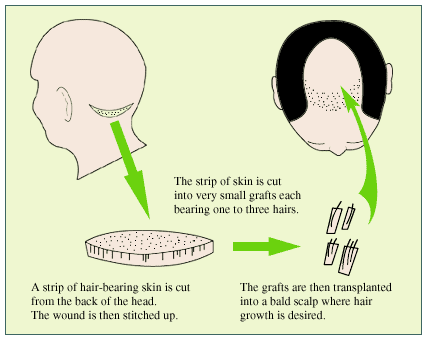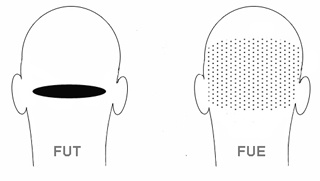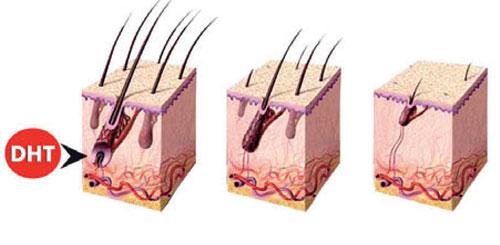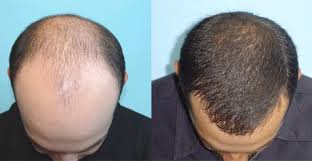Hair transplantation is a surgical procedure used to treat baldness or hair loss (alopecia). Hair follicles are transplanted from a part of the body (donor site) to balding area (recipient site). It is to be noted that this procedure does not create new hair, only redistributes the existing hair.
It is not recommended in patients who do not have enough donor area, have tendency for keloid formation, have hair loss due to medication, etc.
PROCEDURE
There are various techniques.
The first one is FUT (follicular unit transplantation) or strip procedure, which is most commonly followed. Hair units are removed from a donor strip that has been excised from the donor area as from the back and sides of the scalp, and transplanted to the bald areas. Graft may differ in size and shape. Round-shaped punch grafts usually contain about 10-15 hairs, the smaller mini-graft contains about two to four hairs; and the micro-graft, one to two hairs.

The second procedure is FUE (follicular unit extraction), a slower procedure, where the individual hair units are removed directly from the donor area by a micro-punch and transplanted to thinning areas, follicle by follicle.

The third procedure available is DHI (direct hair implantation), which is considered the most advanced technique, is least traumatic and with no scarring. With the help of a specific DHI implanter, single hair follicles are directly implanted in the bald area, with no incision.

Which hair replacement procedure is most suitable depends on the type of hair loss and the individual's preferences.
DURATION
Surgery is done under sedation/local anaesthesia, lasting two to three hours during which approximately 250 grafts can be transplanted.
Three to four sessions may be needed to achieve satisfactory results. After each session, a healing process of two to four months is usually recommended prior to the next procedure.
RECOVERY
Bandage may be applied for a day. Normal activities can be resumed within a day. Strenuous activities should be avoided in the first few days after the surgery.
The transplanted hair will fall out within a few weeks; and new hair will start to grow in the graft sites within about three months. It usually takes 10-12 months to see the full improvement in terms of density.

RISKS
Swelling, infection, scarring, bleeding, decreased sensation at the donor and recipient site, etc may occur. The result may not be as expected, the hair may look artificial.
It is done by a Cosmetic surgeon or a Dermatologist. Skill of the surgeon along with the technique, is very important here. For best results with minimum complications, choose an experienced and skilled surgeon.